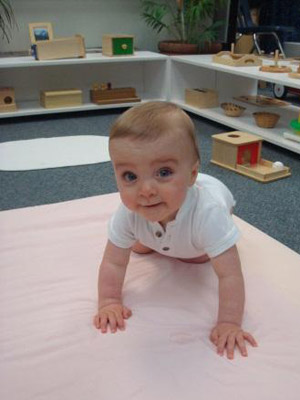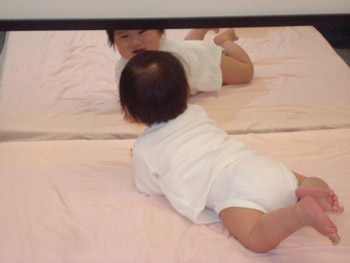For the older child, when we walk into a classroom we expect to see a wide array of work areas including tables, chairs, floor mats, pillows, quiet corners, etc. Yet, when thinking of children under one, we don’t typically understand that as much emphasis should be placed on preparing them a ‘work area.’
From birth, the infant is learning to adapt to his or her world through the senses. One of the most rapid acquisitions in the first year is the development of the movement. From being completely immobile at birth, the young infant goes from producing involuntary to voluntary movement. This happens rapidly during the first year of life as the Myelin Sheath coats the neurons in the body, which is essential for the proper functioning of the nervous system. This Myelination moves from the head to the feet and from the center of the body to the fingertips. Due to this process, the first part of the infant’s body to be Myelinated is the throat and neck, then shoulders, arms, legs, etc. until lastly the child has control of his or her wrists and fingers (refined grasp), along with ankles and toes (child can now walk).

Now, for all this hard work to occur in the first year of life, the young infant needs a place to do it and materials to aid it!
From the time the infant is two to three weeks old (until crawling/walking), he or she should have an area for movement. This includes a movement mat, mirror, and low shelf.
The mat is a dense piece of foam the size of a twin mattress (Approx. L: 75” x W: 40” x H: 2”). It is covered with a tightly fitted sheet (neutral pattern) that is easily washable and underneath you should have a rubberized flannel pad. Ideally, you will have a good-quality mirror mounted to the wall which needs to be the length of the mat. You may also want to have several pillows of different shapes and sizes. Besides the movement mat, there should be a low shelf to hold a variety of materials that you can rotate. You may also want to hang a mobile above the movement mat for the infant to explore with his or her senses.
The infant will spend his or her alert and awake time, ‘working’ on the movement mat. The child should have the opportunity to be both on his or her back and tummy, and later when the child is ready to sit up (5 months) you can prop him or her up with pillows. In the beginning, you will bring the materials one at a time for the child to explore. Later, once the child is more mobile, the materials set out on the low shelf will entice him or her to move towards them and make a choice. It is important to note that during this time you want to keep the child’s body free from clothing restrictions. Clothing is one of the greatest hindrances to the development of movement and we want the child to be successful.

The purpose of the movement mat is to give the child the opportunity to experience the world as a safe and interesting place. This movement mat serves as a point of reference for the child and allows him or her the opportunity to develop voluntary movements and muscles. This aids in the growth of independence and confidence.
There is no need for pricey commercial items such as bouncy chairs, ExerSaucers, etc. which end up overtaking your home. This work area offers the infant exactly what he or she needs at this stage of development.
Enjoy the time observing the infant working on the movement mat, and exploring his or her environment. Rest assured that this area for movement will provide the infant with the greatest opportunity for natural growth in an unrestricted environment.
